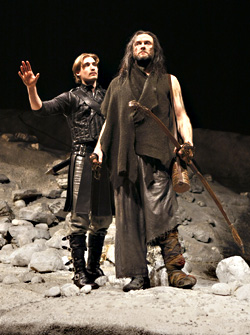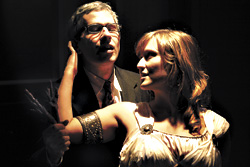Like a hermit crab (or Tom Stoppard), E.L. Doctorow has the kind of imagination that feels most at home in preowned homes. The celebrated popularizer of the ragtime epoch, the Great Depression (Loon Lake, Billy Bathgate, World’s Fair), and the 1960s radical scene (The Book of Daniel) has now burrowed deep into Civil War history and the memoirs of Ulysses S. Grant and William Tecumseh Sherman and colonized the period with his own creations. The March (Random House, $24.95) tells the story of Sherman’s scorched-earth march through the South from the points of view of a fair number of the 60,000 boys in blue who made the rivers run red, plus the freed slaves who tagged along, the dispossessed plantation owners, the yelling Rebs, the battlefield surgeons sculpting ziggurats of severed limbs, the official photographers documenting patriotic gore, the foreign war correspondents, and the products of miscegenation caught guiltily between colliding worlds. Sherman himself is a character, alarmingly manic-depressive and so neurotically addicted to life on the march that when he’s forced to stay indoors in a commandeered mansion, he sleeps in a pup tent on the floor. Grant and Lincoln do cameo roles, and via Sherman’s moody ruminations, we get a sketchy sense of the machinations going on among Secretary of War Edwin Stanton and scheming company—nothing like the historical detail you’ll find in Doris Kearns Goodwin’s Team of Rivals or Joshua Wolf Shenk’s Lincoln’s Melancholy, but wholly absorbing as far as it goes. This isn’t a historical novel designed to give you a coherent account of Sherman’s march. You get a good look at a few tactical moves—Sherman’s feint toward one town or Rebel redoubt so as to smash another, his talented generals’ doublings back and double crossings on the chessboard of the increasingly devastated landscape. You sure don’t grasp the overall strategy. The point is to make you feel the sheer force of the event from moment to moment, reflected in dozens of eyes on all sides. In a way, the book aspires to the condition of one of its wounded characters, Union soldier Albion Simms, who has a spike driven partway through his skull by a gunpowder explosion, leaving him functional except for the loss of all memory. “It’s always now!” he complains, like a cross between Oliver Sacks’ Korsakoff’s syndrome patient, the historical split-brain patient Phineas Gage, and Joseph Heller’s absurdist Soldier Who Saw Everything Twice in Catch-22. As the road unspools beneath his characters’ bleeding, trudging feet, every moment is about as important as the one before and after. Death and coincidental salvation from death are utterly whimsical; the fate of nations and nobodies and ornery mules are all one to the omniscient, implacable narrator. The prose style isn’t exactly period pastiche, but a modernized version of 19th-century language, punchier and poetically heightened, somewhat in the manner of Russell Banks’ John Brown novel Cloudsplitter, but far more skillful. One character, unaware that he’s about to die, nails his last moment with a fugitive observation that scans with an echo of Anglo-Saxon verse: “War changed the weather, it whitened the day—a pungent smoke flew past him like the souls of the dead hurrying to Heaven.” Frustratingly, there are no real central characters, just a marvelous assortment of supporting players whose lives overlap in a rambling, pointed, and poignant yet unfocussed way that reminds me of a Robert Altman film. (Or Robert Altman meets Matthew Brady.) Irascible Georgia slaveholder John Jameson flees his plantation to thwart the imminent Yankee army and argues his way to an early grave; another, cleverer massah waits for the troops, willingly hands over the booty he knows they’re going to take anyway, and prevents most of his slaves from claiming their freedom by sinisterly claiming he can read their minds and knows they’ll starve once they’ve left the cotton fields—an excellent possibility, as the book makes clear. Sherman was running the world’s first automated total-war machine, not a social-service agency. Jameson’s childish wife goes crazy like Mrs. Lincoln, riding along on the march, searching each new cache of dead Rebs for her twin boys. She’s looked after, ambiguously but effectively, by Pearl, the ambitious, cunning, white-skinned offspring of her husband and one of their slaves. She’s about as close to a protagonist as we get, vying with her employer, the brilliantly cold-blooded surgeon Wrede Sartorius, a character fated to show up in Doctorow’s novel The Waterworks, and a pair of misfit Rebel defectors, Arly and Will, whose amusing, flavorful banter is right out of Mark Twain—part the Duke and the Dauphin, part Tom Sawyer and Injun Joe. A Southern belle named Emily Thompson, who turns Florence Nightingale for the Yanks, also carves out an ample space in the story. But moment by moment, lesser characters seize the stage just as dramatically. A stunning mother-and-daughter team sexually hoodwinks a horny, homely, vain hunchback general under Sherman’s command, convincing the buffoon they’re under his command just because he’s under the prettier one, her “hips pounding like a locomotive” as she bends him to her will. A proud, ingenious freedman dubs himself Coalhouse Walker Sr., long before there’s a Coalhouse Walker Jr. in sight—that character will have to wait for Doctorow’s Ragtime to exist. Calvin, the talented black assistant to white photographer Josiah Culp, carries on the trade after his boss dies under the gun of a Southerner who then impersonates Culp and keeps Calvin under his thumb, reversing the dilemma of Melville’s Benito Cereno. The March is a riveting page-turner, certainly one of the finest books of the year, and of Doctorow’s career. And yet it falls short of greatness. Its multiple narrative centers muffle its impact. There is a bit of the deferred revelation that is the driving engine of plot, but not much. Too many black characters are sentimentalized and morally simplified, especially Pearl, who suffers from the victimization of symbolhood, like Pearl in The Scarlet Letter, her literary sister under the skin. The author’s considerable research pays off in verisimilitude, but if he’d been more irresponsible with the facts at his command, like Gore Vidal in Lincoln and Burr, he’d have created something more lifelike and likely to live on in literary history. The book is curiously impersonal. It is also astoundingly multifaceted and smoothly joined, philosophically intriguing, heartrending, thrilling and scary and startling and mournful. It will haunt you. tappelo@seattleweekly.com E.L. Doctorow will appear at UW Kane Hall, Room 130, 7:30 p.m. Tues., Dec. 13.
More Stories From This Author
Local singer Zan Fiskum advances to final 9 on ‘The Voice’
Maple Valley singer has ties to Kent
By
Steve Hunter • May 6, 2020 4:06 pm
Paradiso Festival is on the rocks following lawsuit
Paradiso Festival, one of the most popular annual EDM events in Washington state, may be in trouble after one of…
By
Aaron Kunkler • February 4, 2020 3:30 pm
They wanted to tell true-crime stories, so they started a podcast
“Scene of the Crime” begins its first season in Renton
By
Haley Ausbun • January 29, 2020 12:50 pm







